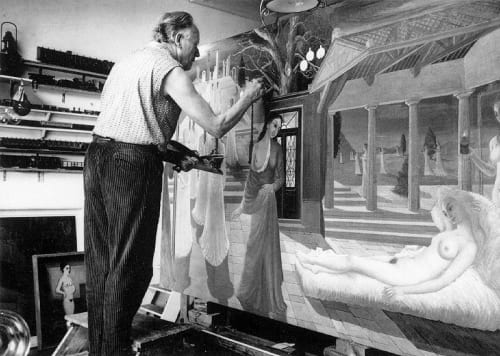Paul Delvaux (1897 – 1994) was alway fascinated by Italy and Greece, destinations he visited multiple times during the course of his long life. In his youth he studied Ancient Greek and Latin, he was keen on Jules Verne's fiction and Homer's Odyssey: all of these aspects would later appear in his paintings, together with recurring figures of skeletons and trains, symbols of the technological progress he witnessed as a child in Brussels.
Delvaux was given solo exhibitions in 1938 at the Palais des Beaux-Arts, Brussels, and the London Gallery, the latter organized by E. L. T. Mesens and Roland Penrose. That same year he participated in the Exposition Internationale du surréalisme at the Galerie des Beaux-Arts in Paris, organized by André Breton and Paul Eluard, and an exhibition of the same title at the Galerie Robert in Amsterdam.
He held in 1945 his first major retrospective at the Palais des Beaux-Arts in Brussels; in 1947 the Julien Levy Gallery of New York exhibited a number of his paintings. He took part in the 27th Venice Biennale in 1954, although his paintings of religious scened enacted by skeletons were censored for heresy by the Church. In 1965 he became president of the Académie Royale de Belgique. A Delvaux retrospective was shown at the National Museum of Modern Art in Tokyo and the National Museum of Modern Art of Kyoto in 1975. In 1977 he became an associate member of the Académie des Beaux-Arts of France.
Throughout his career he worked on numerous monumental paintings, such as La Carte littéraire de Belgique for the 1958 Brussels World's fair and Le Paradis terrestre at the Palais des Congrès (1959). In 1982 the artist attended the opening of the Paul Delvaux Museum; his eyesight had been slowly deteriorating, changing the way he painted and the style of his works. He painted his last canvas in 1986.
His works are now in the Collections of some of the most important international museums and Institutions, such as the Guggenheim Museum of New York and the Peggy Guggenheim Collection in Venice, the Metropolitan Museum and the Museum of Modern Art of New York, the Tate Gallery in London, the Royal Museums of Fine Arts of Belgium, among others.
